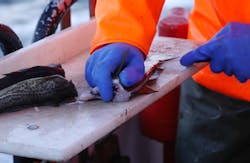Fish filleting residues, rapeseed press cakes turned into valuable products
Byproducts from fish and rapeseed processing have been turned into protein, skin care and biopesticide products as part of an international science project financed by the European Union.
The APROPOS project succeeded in creating new technologies for the production of valuable products from waste that would otherwise end up as animal feed.
Some of these side products could even become the primary product. According to Finnish research organization VTT, the commercial value of protein products made from rapeseed press cakes might be as high as EUR5,000/ton ($5,725/ton). In comparison, the market price of press cakes used as fodder is EUR150-300/ton ($172-344/ton) and the price of rapeseed oil is EUR400-800/ton ($458-916/ton). Each year, 15 million tons of rapeseed press cakes are produced in Europe.
Working as part of the APROPOS project, researchers developed gentle rapeseed processing methods to produce a high stability fraction rich in protein and fibre. They also developed bio-mechanical methods to produce proteins and phenols from rapeseed press cakes for food and cosmetics industry applications. And in peptide-phenol extracts they discovered anti-inflammatory, anti-aging, bacteriostatic, antioxidant and antimicrobial properties, with potential applications in skin care creams and medicinal wound dressings.
Meanwhile, Norwegian researchers developed a manufacturing process to produce protein-rich dietary supplements from filleting residues from Nile perch. The supplements meet African taste preferences and could help increase the protein intake of people living in East Africa.
And a technology has been developed to isolate glucosinolates and protein from mustard press cakes, allowing glucosinolates to be used in pesticides, particularly for agricultural use in arable areas of India.
"The idea of the project was to develop technologies based on which all parts of a raw material can be used, without leaving any waste. In this project, the aim was not to produce fractions of high purity, but to develop methods for achieving practical results beneficial to both the producer and the final product," explained Raija Lantto, head of research at VTT Technical Research Centre of Finland Ltd and coordinator of the APROPOS project.
